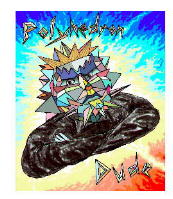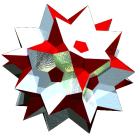compound of 4 oct
©
(at margins)
- between {3} and {3}: arccos(-1/3) = 109.471221°
links




| Acronym | dissit |
| Name |
disnub tetrahedron, compound of 4 oct |
| |
| Circumradius | 1/sqrt(2) = 0.707107 |
| Inradius | 1/sqrt(6) = 0.408248 |
| Vertex figure | [34] |
|
Dihedral angles
(at margins) |
|
| Confer | |
|
External links |




|
This compound has rotational freedom. Starting at φ = 0° with a completely coincident overlay of 4 octahedra, rotating 1 octahedron each, thought of as 3-fold antiprisms, around a tetrahedral subset of trigonal axes, and thereby passing at φ = 60° at sno.
This is the hemi-version of daso.
For an intermediate state of φ the lateral triangles become coplanar, and thus can be considered as (rotated) 2-triangle-compounds. That special case is called hidsit (hexagrammattic disnub tetrahedron). By coincidence, hidsit is nothing but se with 1 oct removed. (J. Bowers further uses idsit (inner ...) for smaller values of φ, resp. odsit (outer ...) for larger values.)
24 | 2 2 | 3 1 || 1 ----+-------+------++-- 2 | 24 * | 1 1 || 1 2 | * 24 | 2 0 || 1 ----+-------+------++-- 3 | 1 2 | 24 * || 1 3 | 3 0 | * 8 || 1 ----+-------+------++-- ♦ 6 | 6 6 | 6 2 || 4
© 2004-2025 | top of page |